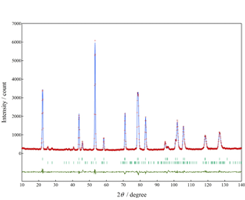Investigation of Average and Local Structures, and Electron-Density Distribution of Lithium Transition-Metal Oxide
Y. Idemoto and N. Kitamura
In recent years, the lithium-ion battery has been expected to be applied for not only portable electronic devices such as a mobile phone but also a vehicle and a storage device and so on. From such background, many researches have devoted their efforts to develop new lithium transition-metal oxides with superior cathode performances. For the development, crystal and electronic structures of the cathode materials must be determined precisely since the structures are well known to affect the cathode properties. Moreover, it is considered recently that local orderings of transition metals in the crystal play an important role for charge and discharge processes. Therefore, it is highly expected to discover local structures hidden in crystal structures. In our recent works, we paid special attention on LiNi0.8Co0.2O2-based materials [1] and Li(Li1/6Mn1/2Ni1/6Co1/6)O2 [2] with the layered structure, and investigated the average and local atomistic structures, and electron-density distribution by using neutron and synchrotron X-ray sources.

Fig. 1. Rietveld refinement pattern of LiNi0.79Zn0.01Co0.2O2. Red pluses and a blue solid line represent observed and calculated intensities, respectively. Vertical marks indicate positions of allowed Bragg reflections (upper marks for LiNi0.79Zn0.01Co0.2O2, and lower marks for Li2CO3). A curve at the bottom is a difference between the observed and calculated intensities in the same scale.
As for LiNi0.8Co0.2O2-based materials, we refined the average structure by the Rietveld analysis using neutron diffraction patterns. The data were measured under ambient condition with HERMES installed at JRR-3. Fig. 1 shows the Rietveld refinement pattern of LiNi0.79Zn0.01Co0.2O2. In the analysis, we assumed the space group as R-3m, and optimized an exchange amount of Li and Ni, which is the so-called “cation mixing”. As a result, the average structure could be successfully refined, and the Ni content at Li site was estimated as 0.056 (3). We could also refined average structures of other LiNi0.8Co0.2O2-based materials with partial Cu substitution and without any substitution (the pristine sample) in the same manner. For the purpose of electronic-structure analysis on the samples, we carried out the maximum-entropy method (MEM) using synchrotron X-ray diffraction patterns. When X-ray diffraction data are used, it is quite difficult to obtain accurate information on light element such as Li and O generally. Therefore, the average structures refined with the neutron diffractions were utilized as the initial structures in the analytical processes. By this strategy, electron-density distributions could be estimated successfully, and then it was found that both the Zn and Cu substitution for LiNi0.8Co0.2O2 tended to reduce a bond strength between the transition-metal and oxygen sites.
In order to investigate the local structure of Li(Li1/6Mn1/2Ni1/6Co1/6)O2 with the layered structure, we firstly performed the average structure refinement (S. G.: C2/m) using neutron Bragg profile recorded at HERMES, and then analyzed the reduced pair distribution function, G(r), which was derived from neutron total scatterings. Prior to the PDF fitting, we constructed the some local-structure models with different metal arrangement which satisfied the site occupancies refined by the Rietveld method, and then relaxed atomic configurations of the models by the density functional theory (DFT) calculation. On the basis of the results, we carried out the PDF fitting only for an energetically-stable model. The PDF analysis indicated that a LiMn6 ordering was formed within the transition-metal layer in the same way as Li2MnO3. In addition, the detailed investigation suggested a local distortion along the c axis which is perpendicular to the layer.
The our works described above demonstrate that the structure analysis using both the neutron and synchrotron X-ray diffractions gives us fruitful information the electronic structure as well as the crystal structure of the cathode materials for the lithium-ion battery. Moreover, a combination of the Rietveld and PDF analyses enable us to gain deeper understanding the atomic configurations of the functional oxides.
References
- [1] Y. Idemoto, Y. Tsukada, and N. Kitamura, Solid State Ionics, 279, 6 (2015).
- [2] Y. Idemoto, K. Akatsuka, and N. Kitamura, J. Power Sources, 299, 280 (2015).
